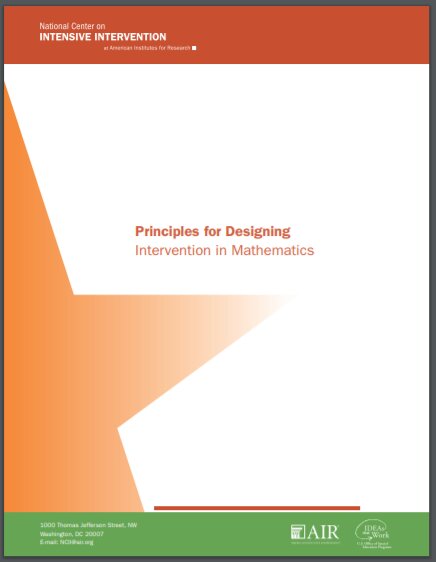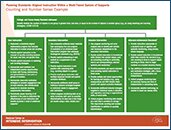Mathematics Sample Lessons to Support Intensifying Intervention
Mathematics Sample Lessons to Support Intensifying Intervention
NCII developed a series of mathematics lessons and guidance documents to support special education instructors, mathematics specialists, and others working with students who struggle with mathematics. These lessons and activities are organized around six mathematics skill areas that are aligned to college– and career-ready standards, and incorporate several instructional principles that may help intensify and individualize mathematics instruction to assist teachers and interventionists working with students who have difficulty with mathematics. The lessons may be used to supplement mathematics interventions, programs, or curricula that are currently in place. However, these lessons by themselves would not constitute an effective mathematics intervention.
In this video, Dr. Sarah Powell shares considerations for teaching students with math difficulty.

The purpose of this guide is to provide brief explanations of practices that can be implemented when working with students in need of intensive intervention in mathematics.
Click on the skill areas below to explore resources and lessons related to each area.
Number System/Counting
Within college- and career-ready standards, place value, numeracy, and counting are taught in Grades 1 and 2. Counting skills cover knowing number names and the counting sequence, counting to tell the number of objects, comparing numbers, extending the counting sequence, and adding and subtracting within 20. Students who struggle with counting often have difficulty with counting principles and understanding numbers and what they represent. These resources may be used as these concepts are introduced or with students in higher grade levels who continue to struggle with the concepts. |
Example

View an example of how standards-aligned instruction for counting may be taught across the continuum of the multi-tiered system of support (MTSS) framework.
Lessons and Activities
The following lessons and activities may be used to develop and customize mathematics instruction and interventions to meet student needs. Each provides considerations for instruction, sample activities with embedded instructional principles, worksheets, and supplemental materials. Instructional videos highlighting these practices also are available.
Teaching Counting Guide (508 compliant version)
- Reviewing Five Counting Principles
- Common Counting Errors
- Counting to 13 with Manipulatives
- Counting to 7
- Counting to 9 in Different Ways
- Counting from 6 to 15
- Counting from 5 to 12 Using a Story Problem
- Start with 4 and Add 2
- "Counting On" to Add 5 + 4
- "Counting On" to Subtract 10 - 4
- Comparing 3 to 7
Basic Facts
Within college- and career-ready standards, basic facts are taught in Grades K–4. Basic facts cover addition and subtraction concepts, adding and subtracting, multiplication and division concepts, and multiplying and dividing. Students who struggle with basic facts may not have mastered prerequisite skills, such as counting, knowledge of numbers, and understanding what numbers represent. In addition, they may struggle with specific basic fact skills, such as understanding symbols, fluency with facts, and selecting strategies to calculate answers. These resources may be used as these concepts are introduced, or with students in higher grade levels who continue to struggle with the concepts. |
Example

View an example of how standards-aligned instruction for basic facts may be taught across the continuum of the MTSS framework.
Lessons and Activities
The following lessons and activities may be used to develop and customize mathematics instruction and interventions to meet student needs. Each provides considerations for instruction, sample activities with embedded instructional principles, worksheets, and supplemental materials. Instructional videos highlighting these practices also are available.
Basic Facts Guide (508 compliant version)
- Using Manipulatives to Illustrate Addition Problem Structures
- Representing 2 + 5 with Objects
- Using Repeated Addition to Illustrate Multiplication
- Demonstrating Combinations of 10 Using Tens Frame
- Demonstrating the Commutative Property of Addition
- Using Manipulatives to Illustrate Subtraction Problem Structures
- Representing 8 – 5 with Objects
- Solving 12 – 7 as an Unknown Addend Problem
- Using Manipulatives to Illustrate Multiplication
- Multiplying 3 × 5 with Concrete Objects
- Dividing 12 ÷ 3 with Objects
- Dividing 12 ÷ 4 Using Objects
Place Value Concepts
Within college- and career-ready standards, place value concepts are taught in Grades K–5. Place value concepts cover such skills as extending the counting sequence and understanding place value. Students who struggle with place value concepts may not have mastered prerequisite skills, such as knowledge or understanding of numbers. In addition, they may struggle with specific place value skills, such as zero, reading numbers, and understanding place value. These resources may be used as these concepts are introduced or with students in higher grade levels who continue to struggle with the concepts. |
Example

View an example of how standards-aligned instruction for place value concepts may be taught across the continuum of the MTSS framework.
Lessons and Activities
The following lessons and activities can be used to develop and customize math instruction and intervention to meet student needs. Each provides a standard aligned lesson, with a clear objective, embedded instructional principles and sample activities.
Place Value Concepts Guide (508 compliant version)
Place Value Computation
Within college- and career-ready standards, place value computation is typically taught in Grades 1–5. Place value computation covers such skills as adding and subtracting (including multi-digit addition and subtraction as well as fluently adding two-digit and multi-digit numbers) and multiplying and dividing (including multiplying and dividing whole numbers of varying digits and multiplying and dividing decimals to the hundredths). Students who struggle with place value computation may not have mastered prerequisite skills, such as basic fact retrieval. In addition, they may struggle with specific computation skills, such as understanding place value, regrouping, and estimating. These resources may be used as these concepts are introduced or with students in higher grade levels who continue to struggle with the concepts. |
Example

View an example of how standards-aligned instruction for place value may be taught across the continuum of the MTSS framework.
Lessons and Activities
The following lessons and activities can be used to develop and customize math instruction and intervention to meet student needs. Each provides a standard aligned lesson, with a clear objective, embedded instructional principles and sample activities.
Place Value Computation Guide (508 compliant version)
- Using Base-10 Blocks to Add 148 + 85
- Adding 417 + 268 Using Partial Sums
- Adding 417 + 268 Using Traditional Algorithm
- Using Base-10 Blocks to Subtract 234 – 88
- Subtracting 614 – 257 Using Partial Differences
- Subtracting 614 – 257 Using Traditional Algorithm
- Using Base-10 Blocks to Multiply 124 × 3
- Multiplying 23 × 19 Using Partial Products
- Multiplying 23 × 19 Using Area Model
- Multiplying 23 × 19 Using Traditional Algorithm
- Multiplying 23 × 19 Using Lattice Multiplication
- Using Base-10 Blocks to Divide 164 ÷ 3
- Dividing 723 ÷ 5 Using Partial Quotients
- Dividing 723 ÷ 5 Using Traditional Algorithm
- Dividing 723 ÷ 5 Using Lattice Division
Fractions as Numbers
Within college- and career-ready standards, fractions are typically taught in Grades 3–5. Developing an understanding of fractions as numbers includes part/whole relationship, number on the number line, equivalent fractions, whole numbers as fractions, and comparing fractions. Students who struggle with fractions may not have mastered prerequisite skills, such as whole number understanding and operations. In addition, they may struggle with specific fraction skills, such as reading fractions, writing fractions, understanding that the larger the denominator the smaller the value of each part, poor understanding of multiples, and understanding the four models of fractions and when to use them (area, sets, measurement, and division). These resources may be used as these concepts are introduced or with students in higher grade levels who continue to struggle with the concepts. |
Example

View an example of how fractions as numbers may be taught across the continuum of the MTSS framework.
Lessons and Activities
The following lessons and activities can be used to develop and customize math instruction and intervention to meet student needs. Each provides a standard aligned lesson, with a clear objective, embedded instructional principles and sample activities.
Fractions as Numbers Guide (508 compliant version)
- Understanding Equivalence: Finding Equivalent Factors for 1/5, 2/5, and 3/5
- Understanding Equivalence: Identifying Fractions Equivalent to 1
- Understanding Equivalence: Examples of Fractions Equivalent to 1/2
- Comparing Fractions with Like Denominators
- Comparing Fractions with Unlike Denominators
- Teaching Fractions Using Manipulatives
- Putting Fractions in Order: Comparing 7/12, 5/8, and 4/6
- Using the Set Model to Understand 1/2
- Using the Set Model to Understand 3/4
- Understanding Equivalence: Comparing Fractions to 1/2
- Understanding Equivalence: How Many 1/8 Pieces are Equivalent to 1/2?
- Understanding Equivalence: Using Fraction Circles to Compare 3/6 and 4/8
- Using Benchmark Fractions to Compare Fractions with Unlike Denominator
- Converting Improper Fractions to Mixed Numbers
- Converting a Mixed Number to an Improper Fraction
Computation of Fraction
Within college- and career-ready standards, fractions are typically taught in Grades 3–5. Computation of fractions covers skills focused on building fractions from unit fractions—applying and extending operations of whole numbers. This includes:
Students who struggle with fractions may not have mastered prerequisite skills, such as whole number understanding and operations. In addition, they may struggle with specific fraction skills, such as reading fractions, writing fractions, understanding that the larger the denominator the smaller the value of each part, poor understanding of multiples, and understanding the four models of fractions and when to use them (area, sets, measurement, and division). These resources may be used as these concepts are introduced or with students in higher grade levels who continue to struggle with the concepts. |
Example

View an example of how computation of fractions may be taught across the continuum of the MTSS framework.
Lessons and Activities
The following lessons and activities can be used to develop and customize math instruction and intervention to meet student needs. Each provides a standard aligned lesson, with a clear objective, embedded instructional principles and sample activities.
Computation of Fractions Guide (508 compliant version)
- Review of Fraction Vocabulary
- Adding Fractions with Like Denominators: An example with 1/8
- Adding Fractions with Like Denominators: An example Using 1/6
- Composing Fractions: 5/8
- Adding Fractions: 4/8 + 3/4
- Adding Fractions: 1/4 + 1/3
- Addition of Fractions with Unlike Denominators: Using Common Denominators
- Adding Fractions with Unlike Denominators: 1/4 + 3/8
- Adding Fractions with Unlike Denominators: 1/2 + 3/5
- Adding Fractions with Unlike Denominators: 2/6 + 3/12
- Adding Fractions with Unlike Denominators: 2/3 + 1/4
- Adding Fractions with Unlike Denominators: 1/4 + 5/8
- Adding and Subtracting Fractions with Like Denominators: An Example with 1/8
- Subtracting Fractions: 3/8 - 1/4
- Subtracting Fractions: 1/2 - 2/5
- Subtracting Fractions with Unlike Denominators: 3/4 - 1/3
- Subtracting Fractions with Unlike Denominators: 2/3 - 2/5
- Multiplying Fractions: 2 x 2/3
- Multiplying Fractions: 3 x 3/4
- Multiplication of Fractions with Area and Length Models
- Converting Mixed Numbers and Improper Fractions: 1 and 3/4
- Converting Improper Fractions to Mixed Numbers: 5/4


